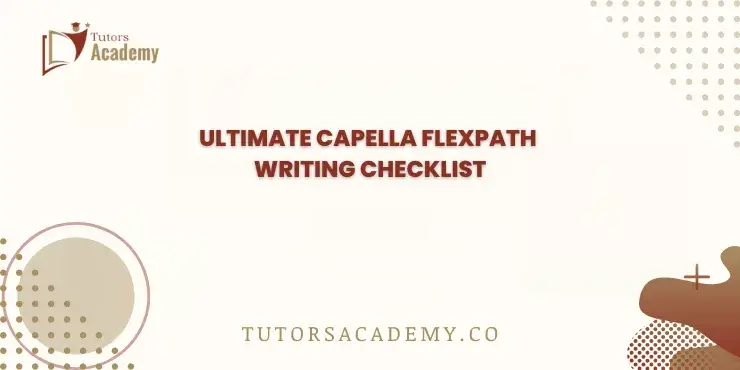
Ultimate Capella FlexPath Writing Checklist
Capella’s FlexPath format is a self-paced program that gives you freedom to complete it at your own pace, but this freedom means more responsibility, too. You choose your pace, manage your time, but you also have to write a lot. And your writing needs to be clear, focused, and academic. That’s not always easy and takes practice. But with the right approach, you can write great assessments every time. This checklist can help. Let’s go through each.
Step 1: Follow the Instructions Carefully
This might sound obvious. Still, many people skip it or just skim through it. That’s not a good approach. You should always start by reading the full instructions. Highlight key words and look for verbs like “analyze,” “explain,” or “compare.” These words guide your response and tell you what to do. If you miss them, you might answer the wrong question.
Also, look for scope. What exactly do they want you to focus on? Is it one topic? Or are there two parts? Finally, if you’re confused, ask. That’s what your FlexPath coach is there for. It’s better to ask a question now than rewrite your whole paper later.
Step 2: Open the Scoring Guide
Every Capella assessment comes with one, and you should use it. The scoring guide (or rubric) shows how your work will be graded. Each criterion tells you what’s expected, and for each one, there’s a list of levels: non-performance, basic, proficient, and distinguished. Focus on the distinguished level, as that’s what you’re aiming for.
As you write, check back often, and after you finish, check again. The scoring guide should shape every part of your paper.
Step 3: Gather Strong Sources
Next, start doing research, but don’t just Google the topic. Start with the Capella Library and use the databases. Find peer-reviewed articles and look for recent studies. You want sources that are reliable, academic, and relevant. Three to five sources are usually enough unless the prompt says otherwise. Make notes and don’t just rely on AI tools to write. List key points in your own words and then use them to write.
Step 4: Outline Your Paper
Before writing your draft, make a plan. It doesn’t have to be detailed. Even a basic structure helps. Start with your main sections that include introduction, body, and conclusion. Then add bullet points. What are your key ideas? What examples will you use? What will each paragraph cover? This step keeps you on track.
Step 5: Write a Clear Introduction
Now you’re ready to write. Start with your introduction. This section should be brief and straightforward. Around four or five sentences will be enough for it. Start with a sentence that tells about the main topic. Then, if needed, give some background information about the topic too. Then, explain what your paper will cover. Try to end with a brief statement that previews your main points. Moreover, avoid vague or broad openings and keep it focused, as clear is better than clever.
Step 6: Develop Focused Body Paragraphs
The body is the main part of your paper. Try to talk and explain just one point in one paragraph. Start with a topic sentence, then support it and use evidence from your research. Then ask, Why does this matter? What does it show?
Make sure to connect the evidence to your argument. Don’t just include a quote; provide context. You can improve your writing by using transitions and phrases like “for example,” “in contrast,” or “as a result.”
Step 7: Show Analysis
Capella values analysis and not just summary, so go deeper and don’t just repeat what the article says. Ask why, how, and make connections. How does one idea relate to another? What’s the bigger picture? Consider the implications as well. What does this actually mean in the real world? You’re doing more than just reporting facts. You get good grades when you show that you understand it and also apply it.
Step 8: Write an Impactful Conclusion
The paper should be wrapped up in your conclusion. Start by telling about your primary point in a new way. After summarizing your research, leave the reader with a thought-provoking question or perhaps a brief reflection. This section should be kept brief. Normally, 5 to 6 lines will be enough.
Step 9: Use Proper APA Format
Pay close attention to the APA style that Capella requires. This comprises a reference list and in-text citations. As required by APA, properly format them using italics, periods, commas, and spacing.
Additionally, use a standard font in size 12. You can use Arial or Times New Roman. Moreover, double-space everything and add a title page too.
Step 10: Proofread Carefully
Don’t submit your first draft right away, but always review it first. Read it out loud, and that’s one of the best tricks. It helps you catch errors your eyes miss.
Check your grammar and look for repeated words. You can use tools like Grammarly or Microsoft Word’s Editor for help, too. But, don’t rely only on them and do a final pass yourself.
Step 11: Match It to the Rubric
Before you submit, go back to the scoring guide and compare your paper to each criterion. Did you meet everything listed under the “distinguished” level?
If not, revise, and if yes, great. Now you’re ready. This last check can make a big difference and help you catch small things.
Conclusion
Writing in FlexPath can feel hard at first. But with practice and the right environment, it gets easier. This checklist gives you that system. Start by understanding the prompt and use the scoring guide as your map. Find strong sources, plan your structure, and write clearly. Do these things each time, and your writing will improve. Slowly, then quickly, and you’ll build confidence. You’ll meet expectations and will even enjoy the process more. Capella wants you to succeed, and this checklist helps you get there.
